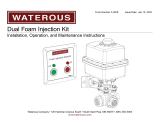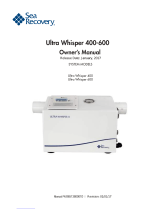
English (GB)
15
A lower flow in the seawater inlet than the seawater discharge will
result in lower-quality permeate, increased feed pressure and
higher energy consumption. We recommend that you use a
slightly oversized BM hp pump (14) to handle projected
membrane concentrate flows, taking into account seasonal
variations, membrane fouling and manifold losses. The flow and
pressure of the BM hp pump (14) must be controlled with a
frequency converter.
To start up the BMS hs pump, proceed as follows:
1. Start the BMS hs (6). See section 6.1.2 Startup.
Fig. 27 System in operation
The BMSX system pressure will increase. The sound pressure
level from the pressure exchanger (23) will increase.
Small variations in sound pressure level and rotor speed are
normal.
6.4 Low-pressure flow control
The concentrate valve (24) on the discharge side of the system
must be adjusted to control the flow rate of the low-pressure
seawater inlet (17) and low-pressure concentrate discharge (22)
(min. 1 bar backpressure). This valve (24) also adds
backpressure on the pressure exchanger (23) required to prevent
destructive cavitation. The low-pressure seawater inlet flow (17)
equals the high-pressure concentrate inlet flow (15).
7. Shutdown
Carefully follow these instructions to safely shut down your
booster system.
7.1 BMS hs system
This procedure describes how to shut down the BMS hs system.
Fig. 28 Example of BMS hs system
Procedure
1. Ramp down the BMS hs pump (6) according to factory
settings. See fig. 29 (3 and 4).
Fig. 29 Ramp down
2. Stop the seawater feed pump (1).
3. Start the fresh-water flush pump (15), and flush the system
with fresh water (14) (min. 2 bar for flushing).
4. Flush the system for 5 to 10 minutes or until the salinity is
lower than 1000 ppm TDS.
5. Stop the fresh-water pump (15).
6. Close all valves to keep the fresh water in the system during
shutdown.
Neither the low-pressure nor the high-pressure
flow through the pressure exchanger must ever
exceed the rated maximum flow. The only reliable
way to determine the flows is to use a low-
pressure flowmeter (16) or a high-pressure
flowmeter (14), respectively.
TM05 8857 2813
1
2
3
4
16
15
14
12
7
9
8
10
18
19
20
13
21
22
24
23
17
5
6
25
26
11
TM05 8860 2813TM05 8860 2813
Ramp down from 1700 to 0 rpm in 3 seconds.
To flush the thrust bearing of the BMS hs pump,
start the pump for 30 seconds to allow the fresh
water to enter into the thrust bearing.
If the flushing takes more than 10 minutes, the
flow must be reduced to maximum 10 % of the
rated flow rate.
During periods of inactivity, the pump must be
filled with clean fresh water.
rpm
3 seconds
t [seconds]
1700






















